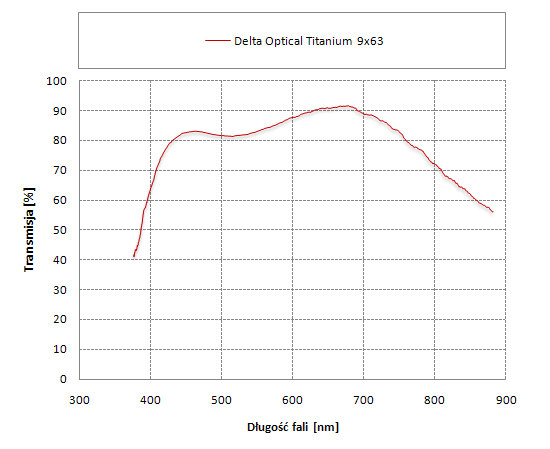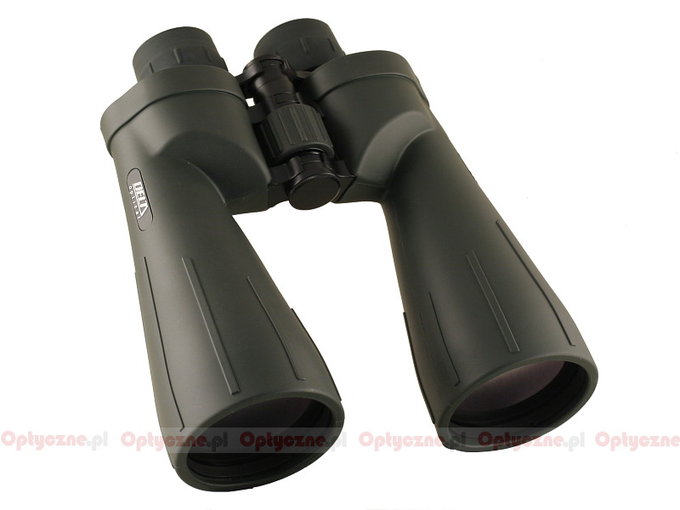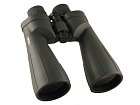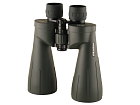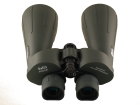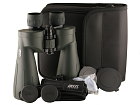In 2006, the Polish Delta Optical company decided to launch a porroprismatic 8x56 set of binoculars. Good optics closed in a waterproof casing and offered at an affordable price made it a real market hit. Small wonder after the initial success the company decided to enlarge its offer. Soon next models, such as 9x63, 10x56 and 7x50 hit the shelves and at the end of 2008 a 8x56 ED model was launched as well.
The 9x63, tested here, is a classic porroprismatic device with typically low light parameters. According to the producer, it will give a splendid image quality with the price tag not too high because of a simple and efficient Porro construction, good quality BaK-4 glass prisms and high quality coatings, which ensure a transmission on one air-to-glass surface amounting to 99.5% and near 93% for all instrument. Additionally, it was put into a solid aluminum casing which is waterproof and nitrogen-filled.
The buyer gets a set of caps, two straps, a cleaning cloth for optics and a solid, hard case. This model comes with a 5-year-long guarantee.
Distribution / Sales:
Delta Optical
web site
| Magnification |
Lens diameter |
Angular field of view |
Prisms |
Eye relief |
Weight |
Price |
| 9 |
63 |
102/1000(5.8o) |
BaK-4/Porro |
? mm |
1240 g |
899 PLN |
|
|
| Real front lens diameter |
Left: 62.81+/-
0.05 mm
Right: 62.84+/-
0.05 mm
|
7 / 8.0 pkt |
| Real magnification |
9.17+/-
0.04x
|
3/3.0 |
| Transmission |
82.7+/-
1.5%
|
11/25.0 |
| Chromatic aberration |
Low in the centre, distinct on the edge. |
6.5/10.0 |
| Astigmatism |
Slight. |
7.2/10.0 |
| Distortion |
The distance of the first curved line from the field centre compared to the field of view radius: 39% +\- 4% |
4/10.0 |
| Coma |
Appears in the distance of about 75-80% from the field centre Medium on the very edge. |
7.5/10.0 |
| Blurring at the edge of the FOV |
The blur occurs in the distance of 72% +\- 3% from the field of view centre. |
3.5/10.0 |
| Darkening at the edge the FOV |
Noticeable but not high. |
4/5.0 |
| Whiteness of the image |
Characteristic hole in the transmission curve for green light and higher transmission for red. Minimal blue hue. |
4.1/5.0 |
| Collimation |
Exemplary. |
5/5.0 |
| Internal reflections |
| Left: |
Right:
|
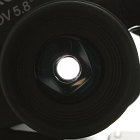 |
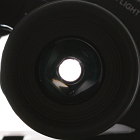 |
Near medium level. |
2.8/5.0 |
| Housing |
A classic Porro construction. Quite handy but padded with slippery rubber which doesn’t ensure a firm grip when you keep it in sweaty or gloved hands (and gloves are made of fabric). Rubber eyecups without regulation. Waterproof and nitrogen-filled. |
6/8.0 |
| Focusing |
Central wheel is comfortable and moves smoothly (full turn at 530 degrees). A classic ocular bridge which moves evenly but with audible squelching of grease. It moves sideways slightly when pressed. Individual focusing on the right eyepiece moves the lens. |
3.9/5.0 |
| Tripod |
There is a comfortable tripod exit. |
3/3.0 |
| Interpupilary distance |
from 54 to 74.2mm
|
5/6.0 |
| Closest focusing distance |
5.05 m |
1.5/2.0 |
| Eyepieces FOV |
Apparent field of view of 53.0 deg (according to simple formula) and 49.7 deg (according to tangent formula). |
5/20.0 |
| Field of view |
Measured by us amounted to 5.78 +\- 0.03 degrees and it was in accordance with the specification within the margin of error. A typical field of view for this class of equipment. |
5/8.0 |
| Quality of the interior of the barrels |
Inner tubes black and matt, the bottom gray but not shiny. Visible white glue. Some small specks of dust. Small scratches on a prism. |
3.4/5.0 |
| Vignetting |
| Left: |
Right:
|
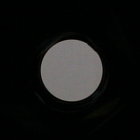 |
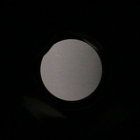 |
OL: 0.9%, OR: 1.3%. |
6.5/8.0 |
| Prisms quality |
Good quality BaK-4. |
8/8.0 |
| Antireflection coatings |
Greenish everywhere. Medium intensity. |
4.5/5.0 |
| Warranty [years] |
5 |
3.5/6.0 |
| Final result |
63.6%
|
120.9 / 190 pkt
|
| Econo result |
|
0pkt. |
Summary
Pros:
- low chromatic aberration in the centre,
- well-corrected astigmatism,
- slight coma,
- low brightness loss on the edge of the field,
- good whiteness rendition,
- good blackening inside the inner tubes,
- high quality prisms made of BaK-4 glass.
Cons:
- too high distortion,
- weak contrast on the edge of the field,
- slightly truncated exit pupils.
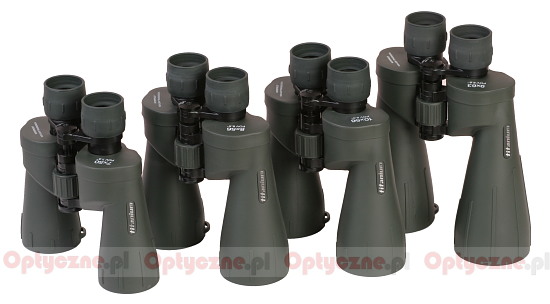
Delta Optical Titanium Porro binoculars.
From left to right: 7x50, 8x56, 10x56 i 9x63. |
The 9x63 model from the Titanium series didn’t fare as well as the 8x56, not to even mention the 8X56 ED. Looking at it objectively, though, the result still remains at least decent. If you glance at the ranking of 9x63 class binoculars, tested by us so far the best result so far was reached by the Ecotone LD-II 9x63 with the score of over 106 points; it is over 12 less than the Delta. The Delta Titanium 9x63 takes the lead in a decisive manner – we haven’t tested so far a better 9x63 instrument.
The 9x63 class of binoculars is quite specific. Such an instrument is a typical night device with the exit pupil of 7 mm. Most of renowned producers don’t manufacture devices in this size, probably assuming that they are already too heavy to be used hand-held. The Titanium 9x63 doesn’t weigh significantly more than an average 8x56 set of binoculars and the difference in size of the objective lens is quite pronounced - an 63 instrument at night will be able to gather as much as 27% of light more than a 56 instrument. It is really a lot. There is a price to be paid for it, though - the increase of dimensions, a bigger weight and a narrower field of view. If you are prepared to pay such a price, the Delta Titanium 9x63 will be a joy to use.

